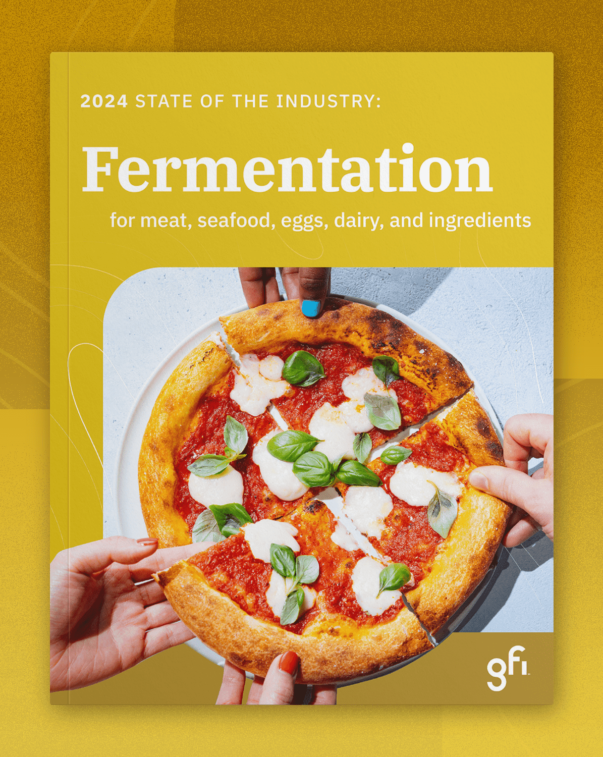
Fermentation
This is your guide to whole biomass fermentation and precision fermentation for alternative protein production. Find background, resources, tools, and expert industry analysis here.
What is fermentation?
Fermentation is a powerful, flexible process for using microorganisms to produce alternative proteins. Fermentation has been used in food production for millennia. Ancient civilizations used microbial cultures to preserve foods, create alcoholic beverages, and improve the nutritional value and bioavailability of foods ranging from yogurt to tempeh. Over the past century, the role of fermentation has expanded far beyond its historical usage to a much broader range of applications. There are many uses of fermentation in the broader alt protein field.
What are the different types of fermentation?
Fermentation for alternative proteins can be broken down into three categories: traditional fermentation, biomass fermentation, and precision fermentation.
Traditional fermentation is the process of changing a food through microbial anaerobic digestion.
This is how beer, wine, yogurt, and cheese are made. For alternative protein production, traditional fermentation can be used to improve the flavor or functionality of plant ingredients, as has historically been the case with tempeh.
Biomass fermentation uses the high-protein content and rapid growth of microorganisms to efficiently make large amounts of protein-rich food.
In this application, the microorganisms that reproduce through this process are themselves ingredients for alternative proteins. For example, Quorn grows filamentous fungi via fermentation to use as the primary ingredient in their products.
Precision fermentation uses microorganisms to produce specific functional ingredients.
The microorganisms are programmed to be little production factories. This is how insulin for diabetic patients is produced, as well as rennet for cheese. Precision fermentation enables alternative protein producers to efficiently make specific proteins, enzymes, flavor molecules, vitamins, pigments, and fats.
Where does fermentation fit in the alternative protein landscape?
In addition to being products themselves, ingredients made with fermentation can be used for plant-based or cultivated products. Increasingly, we may start to think of plant-based, fermentation-derived, and cultivated products as an intersecting venn diagram rather than as three distinct categories.
For plant-based meat, eggs, and dairy, traditional fermentation can help optimize the digestibility, taste, texture, and nutrients of existing plant-based ingredients. Ingredients made with biomass fermentation or precision fermentation can also be combined with plant-based ingredients to make better plant-based meat.
On the cultivated meat side, precision fermentation can help efficiently produce nutrients and growth factors for cell culture media. Furthermore, proteins such as collagen or fibronectin produced through fermentation may serve as key animal-free components of scaffolding for more complex cultivated meat products.
Why is fermentation important?
Alternative protein production is generally much more efficient than conventional meat production. The different types of fermentation offer several unique advantages that can further increase the efficiency of the alternative protein sector as a whole.
Traditional fermentation can help us make better use of existing ingredients.
We’ve used traditional fermentation to transform foods for millennia, and this relatively straightforward use of fermentation has the power to help us make better use of the food already at our disposal. For instance, JBS brand Planterra Foods ferments rice and pea protein with MycoTechnology’s shiitake mycelium for their plant-based meat.
Further, we can minimize food waste and transform low-value agricultural sidestreams into nutritious and delicious food using fermentation. The company PLANETARIANS uses traditional fermentation to improve the digestibility, taste, texture, and nutrients of pressed sunflower cakes—the byproduct of oil extraction.
Biomass fermentation is one of the most efficient ways to produce lots of protein.
The microorganisms used in fermentation reproduce and grow very quickly. The doubling time of these microorganisms is hours, compared to months or years for animals.
Bioreactors are also very space-efficient. When facilities are scaled up, fermentation can produce many tons of biomass every hour.
Many of these organisms are incredibly high in protein content. For species used for biomass fermentation, protein content is more than 50 percent by dry weight. Compare that to about a quarter for conventional beef.
Fermentation’s efficiency has many benefits
Like plant-based and cultivated meat, fermentation-derived protein is better for the planet, people, and animals.
Mycelium, microalgae, microbes, and fermented plant proteins can provide the sensory experiences and positive nutritional aspects of animal products but without undesirable substances, such as cholesterol, antibiotics, and hormones.
Efficient protein production is good not just for human health but for planetary health. This efficiency reduces pollutants and GHG emissions and saves water and land, allowing our food system to be much more sustainable.
Fermentation can also utilize feedstocks that are low-cost industrial or agricultural side streams or waste streams. This lowers both variable and external costs associated with production, such as transportation of inputs. Feedstock diversification will enable local production that leverages readily available feedstocks without long-distance shipping.
What needs to be done to advance fermentation?
Despite microbial fermentation’s long history in food and industrial biotechnology, tremendous potential for innovation remains untapped. Opportunities for advancing fermentation can be segmented into five key areas spanning the value chain: target selection and design, strain development, feedstock optimization, bioprocess design, and end-product formulation and manufacturing.
Although a number of organisms are already used by the fermentation sector, most possibilities have not been fully explored. Existing lines can be further modified for greater efficiency or target specificity. For example, cells can be optimized for production of the desired target molecule via selection and/or engineering.
Fermentation occurs in a bioreactor. The design of the bioreactor plays an important role in the overall efficiency of production, and there are many new bioreactor designs being explored and many more that can and should be explored.
As part of final product formulation and manufacturing, the whole-cell biomass or fractions thereof can be harvested to produce ingredients for alternative meat, egg, or dairy production. Alternatively, a specific target expressed by the cells can be isolated and purified for use as a high-value functional ingredient. The range of options is only now beginning to be explored.

Page
The science of fermentation
Learn about the emerging role of microbial fermentation in building the next generation of alternative protein products.
Discover fermentation research projects
Due to the gap in foundational research for alternative protein science, GFI offers grants for open-access research. This grant program is funded by a select group of generous donors. Learn about our fermentation research grants below.

Fermenting flavor bases
Learn about GFI research grantee BZ Goldberg’s work at The Mediterranean Food Lab to develop better flavors for plant-based meat using fermentation.

Oat protein fermentation
Learn about cutting-edge research to use fermented oat protein to develop plant-based meat.

Fermentation
This is your guide to precision fermentation and whole biomass fermentation for alt protein production. Find resources, tools, and expert industry analysis here.
The growing fermentation market sector
Given fermentations’ many uses, hundreds of companies use fermentation to make a variety of ingredients, materials, and medicines. As interest in alternative proteins has grown, many of these companies have diversified into the alternative protein industry. Recent years have also seen dozens of new startups focused primarily on using fermentation for alternative proteins.

Resource
State of the Industry: Fermentation for meat, seafood, eggs, dairy, and ingredients
This report details the commercial landscape, investments, regulatory developments, and scientific progress in the fermentation for alternative proteins industry.
Featured resources

GFIdeas Community
Learn from and network with experts in alternative protein. GFIdeas is a community for entrepreneurs, scientists, students, and subject matter experts.

Startup manual
This guide lays out the steps involved in starting an alternative protein company, from securing funding and developing your product to scaling up and expanding distribution.

Investor directory
Find hundreds of investors interested in funding alternative protein companies in GFI’s investor directory.

GFI’s 2020 Fermentation Symposium
Watch speakers and panelists who are working to revolutionize the alternative protein industry through fermentation.
Why we need public funding for fermentation research
The world’s leading governments grow their economies by investing in cutting-edge research. We have seen public research pay off. For example, the technologies that went into our cell phones — two-way radio, microprocessors, the internet, miniaturized sensors, touch screens—were all developed in part with public research funding.
Governments around the world already spend billions of dollars on incremental agricultural research, tens of billions on renewable energy, and even more on global health. Putting just a fraction of that toward alternative protein research would have huge payoffs in all those areas and more. Benefits include creating good, secure jobs, protecting the public from infectious diseases, and lessening agriculture’s adverse impact on the climate.

Page
Securing government funding
Government support will accelerate the growth of alternative proteins. Learn how GFI works to secure public funds for alternative protein research.
Making the case
GFI advocates public investment in alternative protein research and fair public policy. Through letters to the FDA and state legislators and governors as well as through participation in lawsuits, GFI helps level the playing field for fermentation.

Page
Environmental benefits of alternative proteins
How eco-friendly are plant-based and cultivated meats? Explore their climate impacts and resource requirements relative to conventional meat.
Expert perspectives
The field of fermentation is moving fast. GFI keeps readers up-to-date through regular posts from our experts around the world.

Meet Sneha Singh, GFI India’s Managing Director
This profile is part of our new “People you should know” series, spotlighting alternative protein innovators and champions around the world.

Alt Protein Project Alumni: Where are they now?
Explore how Alt Protein Project alumni are building community, uplifting new ideas, and shaping their careers.

Let’s do this: How core values can fuel progress in 2025 and beyond
Our commitment to protein innovation keeps growing stronger, thanks to deep-rooted values and a global network driving change.
Three themes that capture our 2024
Going beyond the headlines to the people, places, and spaces advancing alternative proteins.

Building the next generation of alternative protein innovators
We are excited to introduce our 2024 Research Grant Program outcomes, continuing our support for groundbreaking research in alternative proteins.

The reality of securing investment to scale alternative proteins
The funding environment for alternative protein companies has shifted dramatically–but paths forward are emerging.

Meet our new vice president of science and technology
We sat down with Amanda Hildebrand for a podcast-style interview.

Global alternative protein trends to watch
Take a look at how alternative protein solutions are advancing around the world.
Header image courtesy of Meati Foods

Support our work
Our work to advance and accelerate fermentation is made possible by our generous, global family of donors. Philanthropic support is vital to our mission. Connect with us today to discuss how you can help fuel this transformative work.

To OMB on research funding in Fiscal Year 2022
To the Senate Democrats’ Special Committee on the climate crisis on impact of climate change on agricultural economy